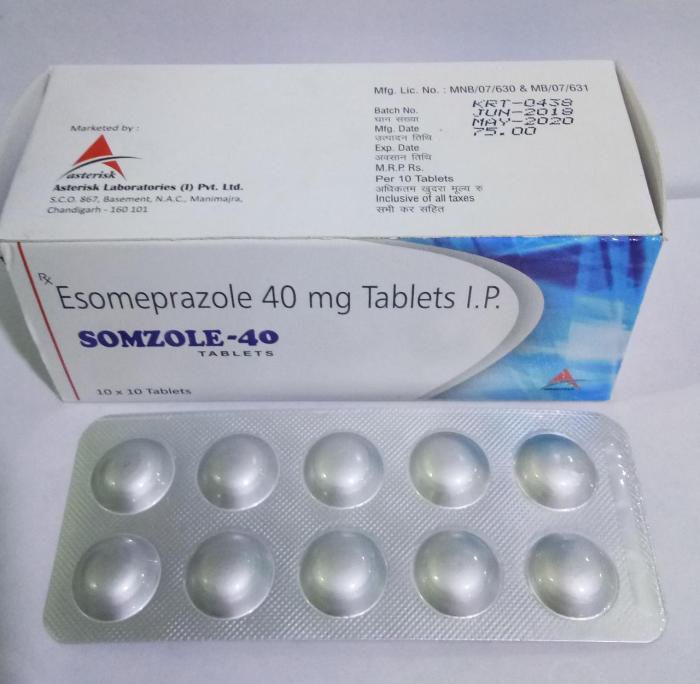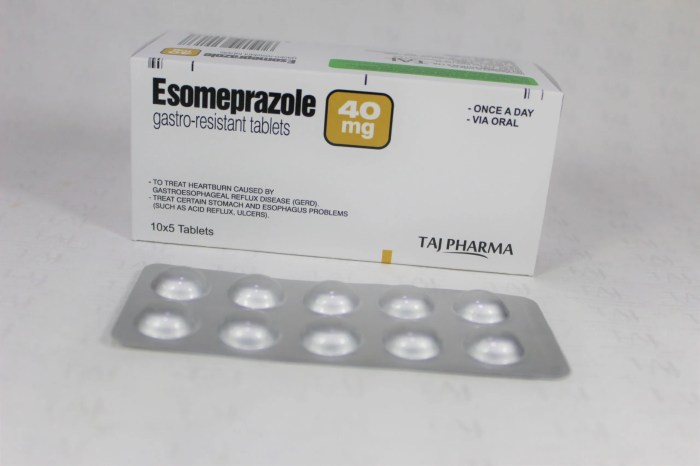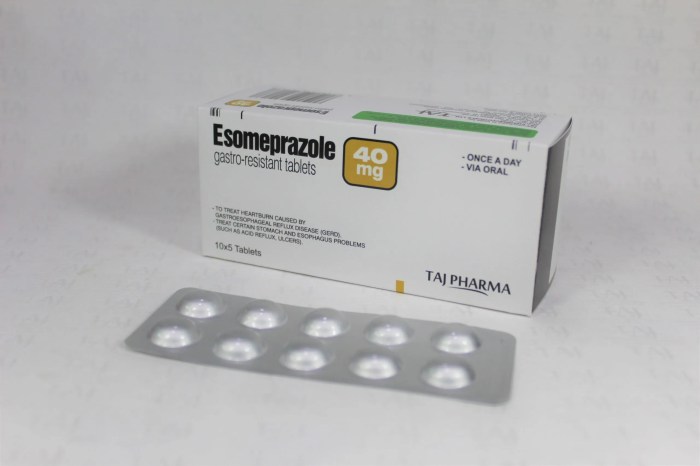Esomeprazole 40mg, a proton pump inhibitor (PPI), is a widely prescribed medication used to treat various conditions related to excessive stomach acid production. This comprehensive guide delves into the intricacies of esomeprazole 40mg, exploring its mechanism of action, therapeutic applications, pharmacokinetic profile, adverse effects, and considerations for patient use. We will also examine the long-term implications of esomeprazole 40mg use, alternative treatment options, and compare it to other PPIs on the market.
Understanding the nuances of esomeprazole 40mg is crucial for healthcare professionals and patients alike. By gaining insights into its properties, potential benefits, and risks, individuals can make informed decisions about their health and treatment plans.
Therapeutic Applications
Esomeprazole 40mg is a proton pump inhibitor (PPI) used to treat a variety of conditions related to excess stomach acid. It works by blocking the production of acid in the stomach.
Gastroesophageal Reflux Disease (GERD)
GERD is a chronic condition where stomach acid flows back up into the esophagus, causing heartburn, indigestion, and other symptoms. Esomeprazole 40mg is a commonly prescribed medication for GERD.
The typical dosage for GERD is 40mg once daily, taken before a meal.
Esomeprazole 40mg can help reduce the frequency and severity of GERD symptoms, providing relief and improving quality of life.
Peptic Ulcer Disease (PUD)
PUD is a condition characterized by sores in the lining of the stomach or duodenum. Esomeprazole 40mg is used to treat and prevent PUD.
The typical dosage for PUD is 40mg once daily, taken before a meal.
Esomeprazole 40mg can help heal existing ulcers and prevent new ones from forming.
Zollinger-Ellison Syndrome (ZES)
ZES is a rare condition caused by tumors that produce excessive amounts of gastrin, a hormone that stimulates acid production. Esomeprazole 40mg is used to manage the high levels of stomach acid in ZES.
The dosage for ZES is individualized and may be higher than the standard dosage for other conditions.
Esomeprazole 40mg can help control the symptoms of ZES, such as heartburn, nausea, and vomiting.
Other Conditions
Esomeprazole 40mg may also be used to treat other conditions, such as:
- Erosive esophagitis
- H. pylori infection
- Stress ulcers
- Dyspepsia (indigestion)
Pharmacokinetic Profile: Esomeprazole 40mg

Esomeprazole, a proton pump inhibitor, undergoes a complex pharmacokinetic profile, which involves absorption, distribution, metabolism, and excretion. Understanding these processes is crucial for optimizing its therapeutic efficacy and minimizing potential adverse effects.
Absorption
Esomeprazole is rapidly absorbed from the gastrointestinal tract after oral administration, reaching peak plasma concentrations within 1-2 hours. The absorption process is influenced by the presence of food, with a slight delay in absorption time observed when esomeprazole is taken with food. The bioavailability of esomeprazole is approximately 64% and is not significantly affected by the route of administration.
Distribution, Esomeprazole 40mg
Following absorption, esomeprazole is widely distributed throughout the body, with a volume of distribution of approximately 0.7 L/kg. It is highly bound to plasma proteins, with a binding rate of approximately 97%. Esomeprazole readily crosses the placenta but is only minimally excreted in breast milk.
Metabolism
Esomeprazole undergoes extensive metabolism in the liver, primarily by the cytochrome P450 (CYP) enzyme system. The primary metabolic pathway involves CYP2C19, which converts esomeprazole to its active metabolite, hydroxy-esomeprazole. Other CYP enzymes, such as CYP3A4, also contribute to the metabolism of esomeprazole.
Excretion
Esomeprazole and its metabolites are primarily excreted in the urine, with approximately 80% of the administered dose eliminated within 24 hours. A small amount of esomeprazole is also excreted in the feces. The elimination half-life of esomeprazole is approximately 1.3 hours, which means that it takes about 1.3 hours for the plasma concentration of esomeprazole to decrease by half.
Factors Affecting Pharmacokinetic Profile
Several factors can influence the pharmacokinetic profile of esomeprazole, including:
- Age: Elderly patients may experience a slower metabolism and elimination of esomeprazole, leading to increased drug levels in the body.
- Renal function: Patients with impaired renal function may have reduced excretion of esomeprazole, potentially leading to drug accumulation.
- Hepatic function: Patients with impaired hepatic function may have reduced metabolism of esomeprazole, potentially leading to increased drug levels in the body.
- Concomitant medications: Co-administration of other drugs that inhibit or induce CYP2C19 can alter the metabolism of esomeprazole, affecting its plasma levels.
- Food: Taking esomeprazole with food can slightly delay its absorption but does not significantly affect its overall bioavailability.
Half-life and Time to Reach Peak Concentration
The elimination half-life of esomeprazole is approximately 1.3 hours, indicating that it is relatively rapidly eliminated from the body. The time to reach peak plasma concentration (Tmax) is typically 1-2 hours after oral administration.
Adverse Effects and Interactions

While esomeprazole is generally well-tolerated, like any medication, it can cause adverse effects and interact with other drugs. Understanding these potential issues is crucial for safe and effective use.
Common Adverse Effects
Adverse effects associated with esomeprazole are generally mild and transient. However, it’s essential to be aware of these potential issues and seek medical advice if they persist or become severe.
- Gastrointestinal Issues: The most common adverse effects are gastrointestinal in nature. These include diarrhea, constipation, nausea, abdominal pain, and flatulence. These effects are usually mild and resolve on their own.
- Headache: Headache is another common side effect that can occur in some individuals.
- Muscle and Bone Pain: Some patients may experience muscle or bone pain, which can be related to the drug’s effects on calcium absorption.
- Rare but Serious Adverse Effects: While less common, esomeprazole can also cause more serious adverse effects, such as:
- Hypomagnesemia: Prolonged use of esomeprazole can lead to low magnesium levels in the blood (hypomagnesemia), which can cause muscle weakness, fatigue, and irregular heartbeat.
- Fractures: Some studies suggest a potential association between long-term use of proton pump inhibitors (PPIs) like esomeprazole and an increased risk of bone fractures.
- Hepatic Issues: Rarely, esomeprazole can cause liver problems, such as hepatitis or liver failure.
- Allergic Reactions: Although uncommon, allergic reactions to esomeprazole can occur, ranging from skin rashes to severe anaphylaxis.
Drug Interactions
Esomeprazole can interact with various medications, affecting their effectiveness or increasing the risk of adverse effects. It’s crucial to inform your doctor about all medications you are taking, including over-the-counter drugs, herbal supplements, and vitamins, before starting esomeprazole.
- Clopidogrel: Esomeprazole can reduce the effectiveness of clopidogrel, a medication used to prevent blood clots.
- Warfarin: Esomeprazole can increase the effects of warfarin, a blood thinner, leading to an increased risk of bleeding.
- Atazanavir: Esomeprazole can reduce the absorption of atazanavir, a medication used to treat HIV infection.
- Methotrexate: Esomeprazole can increase the levels of methotrexate, a medication used to treat cancer and autoimmune diseases, increasing the risk of its side effects.
Monitoring for Adverse Effects and Interactions
It’s essential to be aware of potential adverse effects and interactions with esomeprazole and to monitor for any changes in your health.
- Regular Follow-up: Regular follow-up appointments with your doctor are crucial to monitor your response to esomeprazole and identify any potential problems early.
- Report Any Side Effects: Report any unusual or concerning symptoms to your doctor immediately.
- Medication List: Keep a list of all medications you are taking, including over-the-counter drugs, herbal supplements, and vitamins, and share this list with your doctor and pharmacist.
Patient Considerations
It’s important to consider the individual needs and circumstances of patients when prescribing esomeprazole 40mg. This includes understanding contraindications, potential risks and benefits for specific patient groups, and providing appropriate patient education.
Contraindications
Esomeprazole 40mg is contraindicated in patients with known hypersensitivity to esomeprazole or any other component of the formulation. It is also contraindicated in patients who are concurrently taking atazanavir.
Risks and Benefits in Specific Patient Groups
Pregnant Women
While esomeprazole has not been shown to cause major birth defects, it is classified as Pregnancy Category C by the FDA. This means that animal studies have shown adverse effects on the fetus, but there are no adequate and well-controlled studies in pregnant women. Esomeprazole should only be used during pregnancy if the potential benefits outweigh the potential risks to the fetus.
Elderly Patients
Elderly patients may be more susceptible to adverse effects from esomeprazole, such as confusion, hallucinations, and delirium. However, there is no evidence that esomeprazole needs to be adjusted in elderly patients.
Patient Education
It is crucial to educate patients about the proper use of esomeprazole 40mg, potential side effects, and interactions with other medications. Patients should be advised to:
- Take esomeprazole exactly as prescribed by their doctor.
- Swallow the capsules whole, without chewing or crushing them.
- Take esomeprazole with a full glass of water.
- Do not take esomeprazole if they are allergic to it or any of its ingredients.
- Report any unusual or severe side effects to their doctor immediately.
- Inform their doctor about all medications, including over-the-counter medications, vitamins, and herbal supplements, they are taking.
- Do not share their esomeprazole with anyone else.
- Store esomeprazole at room temperature, away from light and moisture.
Clinical Studies and Research

Extensive clinical trials have been conducted to assess the efficacy and safety of esomeprazole 40 mg in treating various conditions. These studies have provided valuable insights into its therapeutic benefits, potential risks, and optimal dosage regimens. Ongoing research continues to explore new applications, formulations, and potential interactions of esomeprazole 40 mg.
Key Findings from Clinical Trials
Clinical trials have consistently demonstrated the effectiveness of esomeprazole 40 mg in treating a range of gastrointestinal disorders, including:
- Gastroesophageal Reflux Disease (GERD): Esomeprazole 40 mg has been shown to effectively reduce symptoms of GERD, such as heartburn, regurgitation, and chest pain, and promote healing of esophageal erosions. Studies have shown that esomeprazole 40 mg is more effective than placebo and comparable to other proton pump inhibitors (PPIs) in managing GERD symptoms.
- Peptic Ulcer Disease (PUD): Esomeprazole 40 mg is highly effective in treating both gastric and duodenal ulcers. It helps to accelerate ulcer healing and prevent recurrence. Studies have demonstrated that esomeprazole 40 mg is superior to placebo and comparable to other PPIs in healing PUD.
- Zollinger-Ellison Syndrome (ZES): Esomeprazole 40 mg is a mainstay treatment for ZES, a rare condition characterized by excessive production of gastric acid. It effectively controls hypersecretion of gastric acid and reduces the risk of complications, such as ulcers and bleeding.
- Helicobacter pylori (H. pylori) Infection: Esomeprazole 40 mg is often used in combination with antibiotics to eradicate H. pylori infection, a major cause of gastritis and ulcers. Studies have shown that esomeprazole 40 mg significantly increases the eradication rate of H. pylori when combined with appropriate antibiotics.
Ongoing Research
Ongoing research on esomeprazole 40 mg is focused on exploring:
- New Applications: Research is underway to evaluate the potential of esomeprazole 40 mg in treating other conditions, such as gastrointestinal cancers, inflammatory bowel disease, and irritable bowel syndrome.
- Novel Formulations: Researchers are investigating new formulations of esomeprazole 40 mg, such as delayed-release capsules and oral disintegrating tablets, to improve patient convenience and compliance.
- Interactions with Other Medications: Ongoing research is exploring potential interactions between esomeprazole 40 mg and other medications, including those used to treat heart disease, infections, and cancer.
Areas for Further Research
Despite extensive research, there are still areas where further investigation is needed regarding esomeprazole 40 mg:
- Long-term Effects: The long-term safety and efficacy of esomeprazole 40 mg, particularly in individuals taking it for extended periods, requires further study. Long-term use of PPIs has been associated with potential risks, such as bone fractures, vitamin B12 deficiency, and Clostridium difficile infection. Further research is needed to understand the long-term impact of esomeprazole 40 mg on the human body.
- Optimal Dosage Regimens: Research is ongoing to determine the optimal dosage and duration of esomeprazole 40 mg treatment for various conditions. Factors such as age, weight, and underlying medical conditions may influence the appropriate dosage regimen.
- Individualized Therapy: Personalized medicine approaches are being investigated to tailor esomeprazole 40 mg therapy to individual patients based on their genetic makeup and other factors. This could potentially optimize treatment outcomes and minimize adverse effects.
Comparison with Other Proton Pump Inhibitors
Esomeprazole 40mg is a commonly prescribed proton pump inhibitor (PPI) used to treat various conditions related to excessive stomach acid production. It is important to understand how esomeprazole compares to other commonly used PPIs in terms of efficacy, safety, and cost.
Efficacy and Safety Comparison
The efficacy and safety profiles of different PPIs are generally similar, with some subtle variations.
- Efficacy: Most PPIs, including esomeprazole, are highly effective in reducing stomach acid production. They are all equally effective in treating conditions like gastroesophageal reflux disease (GERD), peptic ulcer disease, and Zollinger-Ellison syndrome. However, there may be slight differences in the speed of symptom relief and the duration of effect between different PPIs.
- Safety: All PPIs can cause similar side effects, including headache, diarrhea, and nausea. Long-term use of PPIs has been associated with an increased risk of bone fractures, infections, and vitamin B12 deficiency. The specific risks associated with each PPI may vary slightly, and careful monitoring is important.
Cost Comparison
The cost of PPIs can vary significantly depending on the specific brand, dosage, and pharmacy.
- Generic vs. Brand Name: Generic PPIs are generally much cheaper than brand-name versions. Esomeprazole is available as both a generic and brand-name medication.
- Dosage: The cost of a PPI may also vary depending on the dosage. Higher doses generally cost more.
- Pharmacy: The price of PPIs can vary between different pharmacies. It is often helpful to compare prices at several pharmacies before purchasing.
Advantages and Disadvantages of Different PPIs
- Esomeprazole: A common PPI with a good safety profile and generally well-tolerated. It is available as a generic, making it a cost-effective option.
- Omeprazole: Another widely used PPI, often considered a good first-line option due to its efficacy and cost-effectiveness. It is available as a generic.
- Lansoprazole: Similar to esomeprazole and omeprazole in terms of efficacy and safety. It is available as a generic.
- Pantoprazole: A PPI known for its long duration of action. It is available as a generic.
- Rabeprazole: A PPI with a rapid onset of action. It is available as a generic.
Key Characteristics of Different PPIs
| PPI | Efficacy | Safety | Cost | Other Characteristics |
|---|---|---|---|---|
| Esomeprazole | High | Good | Low (generic) | Available in various formulations |
| Omeprazole | High | Good | Low (generic) | Commonly used first-line option |
| Lansoprazole | High | Good | Low (generic) | Available in various formulations |
| Pantoprazole | High | Good | Low (generic) | Long duration of action |
| Rabeprazole | High | Good | Low (generic) | Rapid onset of action |
Esomeprazole 40mg remains a valuable tool in managing various gastrointestinal conditions. Its efficacy, safety profile, and versatility have made it a mainstay in medical practice. However, it’s essential to remember that every individual responds differently to medications, and potential risks and side effects must be considered. Open communication with healthcare providers and a comprehensive understanding of esomeprazole 40mg are key to optimizing treatment outcomes and ensuring patient well-being.